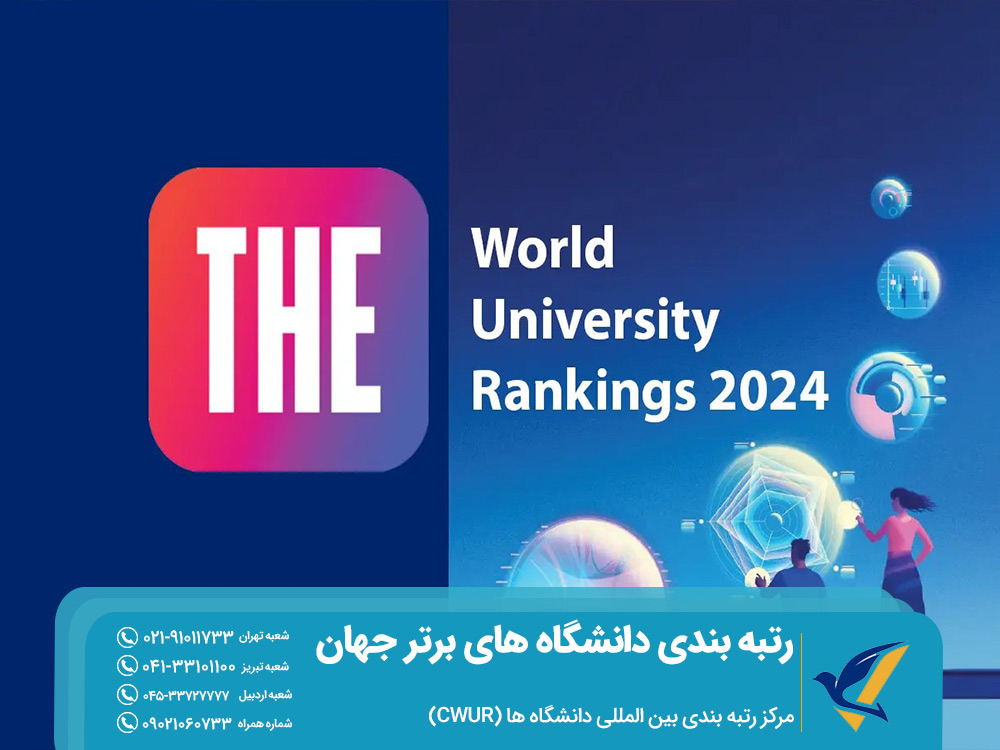World University Rankings 2025
Each year, the top universities in the world are ranked based on specific metrics and indicators, and the position of some institutions may change from year to year. Factors such as the academic and professional quality of faculty members, research facilities, adherence to educational standards, and the number of international awards won are among the key criteria used in global university rankings.
Some universities consistently rank at the top, as they dedicate a significant portion of their resources to research, high-impact scientific studies, and attracting top-tier students. In this article by the Elm Vira Migration Group, we’ll explore the 2025 global university rankings and the key factors that influence them.
Key Indicators in Global University Rankings
Every year, reputable international institutions release rankings of the world’s top universities based on various academic criteria. These rankings are particularly important to talented students and leading institutions around the globe. Factors such as faculty quality, teaching standards, scientific and research equipment, the number of top-performing students, and the availability of scholarships are all important metrics in determining a university’s global standing.
In addition to these, other factors—like the number of official university websites and even the size of a university’s campus—can influence rankings. However, the most crucial criterion in nearly all ranking systems is the quality of education. This is often measured by the number of graduates and the international awards they receive, especially Nobel Prizes.
Several prominent global institutions conduct university rankings, and the reputation and credibility of a university play a major role in these assessments. Each organization, however, uses its own methodology and set of indicators.
Some of the Most Important Global University Ranking Indicators Include:
- Quality of education
- Academic and professional level of faculty
- University research activities
- Research output and funding
- Number of papers published in reputable academic journals
- The volume of backlinks to the university website
- Number of citations and references to faculty research
- Number of international faculty and students
- University productivity, including books and journals published
- Student-to-faculty ratio and faculty with indexed publications
- Academic conferences, collaborations, and partnerships with other global institutions
As noted, each ranking institution uses its methodology and selection of indicators. The list above is a compilation of the most commonly used criteria in global university rankings.

Global University Ranking Institutions
One of the most important factors for top international students when choosing a university is its global ranking. Before 1998, the main criterion for studying abroad was simply how advanced the host country was. However, in 1998, the then-President of China asked Shanghai Jiao Tong University to create a ranking system to evaluate global universities based on academic excellence.
The goal of China’s initiative was to assess the gap between Chinese universities and top global institutions—and ultimately, to improve the quality of its own higher education system. The first global university rankings were released in 2003, and since then, they have been updated annually to reflect changes and introduce the world’s best universities. Today, several key institutions are responsible for these rankings, the most prominent of which include:
1. QS (Quacquarelli Symonds)
QS is one of the most well-known institutions for global university rankings. It uses a unique set of indicators to evaluate universities, including:
Among these, academic reputation carries the most weight, accounting for 40% of the total score. A lower student-to-faculty ratio contributes positively to a university’s ranking, with a weight of 20%. The citation rate—which reflects how often a university’s research is referenced—also contributes 20% to the final score.
The remaining 20% is split evenly between internationalization indicators: 10% for the proportion of international faculty and students, and 10% for employer reputation, which is determined through surveys assessing the perceived quality of a university’s graduates by academics and employers alike.

2. Shanghai Ranking (ARWU)
Another major institution for global university rankings is the Shanghai Ranking Center, also known as the Academic Ranking of World Universities (ARWU). This system evaluates universities based on several key factors: the volume of published research, citation frequency, the number of Nobel Prizes and other prestigious awards received by faculty and alumni, as well as research output indexed in SSCI (Social Sciences Citation Index) and SCIE (Science Citation Index Expanded). Each of these criteria contributes equally—20%—to the overall score.
3. CWTS Leiden Ranking – Science and Technology Studies
The CWTS Leiden Ranking focuses on scientific performance, especially in science and technology. One of the strengths of this system is that its metrics are relative, meaning it does not discriminate between large and small universities. Its core indicators include:
- Impact: measured by the number of global citations received by the university’s publications
- Collaboration: assessing the extent of international cooperation between universities
- Scientific output: based on the number of articles published in reputable academic journals
4. Times Higher Education (THE) Ranking
The Times Higher Education (THE) World University Rankings use 13 performance indicators grouped into five key areas. Among them, teaching, research, and citations (research influence) each carry a weight of 30%, making them the most influential. Other factors include industry income and international outlook, which each account for 5% of the total ranking.
5. Webometrics Ranking
The Webometrics Ranking of World Universities, developed by the Cybermetrics Lab (CINDOC)—part of Spain’s National Research Council (CSIC)—assesses over 15,000 universities worldwide. It evaluates universities based on their web presence and digital impact. Key indicators include:
- The volume of web content and accessible data
- Number of scientific articles published online
- Visibility and openness of web-based information
- Number of external backlinks
- The ratio of meaningful academic content to total web presence

6. Center for World University Rankings (CWUR)
The CWUR evaluates universities based on four main criteria: quality of education, alumni employment outcomes, research quality, and faculty distinction.
-
The quality of education is assessed by the number of students who have won major international awards or medals in competitions such as the Olympiads. This criterion contributes up to 25% of the total score.
-
The faculty quality also carries 25%, measured by the number of faculty members who have received significant international awards and recognition.
-
Another 25% is based on the professional success of alumni, particularly their positions in top companies and institutions globally.
Other global ranking indicators used by CWUR—such as the number of international patents, research papers published in prestigious journals, and citation counts—each carry 5% of the overall ranking weight.
Global University Rankings Overview
As discussed, the world’s leading university ranking systems evaluate institutions based on specific metrics related to education quality, research output, and academic reputation. Each ranking organization prioritizes different factors in its methodology.
According to the latest 2025 QS World University Rankings, the top universities in the world are:
-
Massachusetts Institute of Technology (MIT)
-
Imperial College London
-
University of Oxford (UK)
-
Harvard University
-
University of Cambridge
-
Stanford University
-
ETH Zurich – Swiss Federal Institute of Technology
-
National University of Singapore (NUS)
-
University College London (UCL)
-
California Institute of Technology (Caltech)
As seen, universities from the United States and the United Kingdom dominate the top of the list.
Interestingly, 71 Chinese universities are featured among the world’s best, with Peking University and Tsinghua University ranked among the global top 20. Additionally, National University of Singapore (NUS) ranks 8th globally, while Nanyang Technological University (NTU) has claimed the 14th spot in the world.

Top Universities in Europe
In the latest global university rankings, 197 universities and academic institutions with strong global indicators have been recognized among the world’s best. Notably, European universities have also achieved remarkable success in these rankings. Four universities from the United Kingdom are featured in the top 10 universities worldwide. Following the UK, top European universities include institutions from Switzerland, France (PSL University), and Germany (Technical University of Munich, one of the universities recognized by the Ministry of Science in Iran), all of which are among the top 10 universities in Europe.
Why Global University Rankings Matter
The world’s top universities symbolize a deep commitment to education and research. These institutions are among the most credible sources of global knowledge, offering unparalleled research opportunities and diverse academic programs. The primary goals of global university rankings include assessing the quality of education, scientific research, and the capabilities of faculty members. The key reasons and benefits of these rankings are:
- Attracting top international students
- Enhancing the quality of education and research
- Boosting the university’s global reputation
- Attracting leading scholars and professors for academic collaboration
- Strengthening students’ résumés and improving job market value
- Promoting international academic exchanges and partnerships
- Increasing investment in academic, educational, and research infrastructure to maintain or improve rankings
For these reasons, top global universities strive to meet and exceed international ranking indicators, which include academic performance, financial health, sociological impact, and environmental sustainability.
Conclusion
Global university rankings are a crucial benchmark for elite international students when making decisions about their academic and professional futures. Every year, several ranking institutions around the world evaluate and publish lists of the best universities based on a wide range of global criteria. Academic performance, financial resources, sociological indicators, and environmental impact are among the most important factors considered.
According to the most recent data, the Massachusetts Institute of Technology (MIT) in the United States has once again claimed the top spot in the world for the 13th consecutive year, in the 2025 rankings. Imperial College London and the University of Oxford from the UK secured the second and third places, respectively.
At Elm Vira Immigration Institute, a pioneer in educational migration, we are committed to providing the most up-to-date information about studying abroad. With a team of experienced consultants, lawyers, and legal experts, Elm Vira offers you the most reliable and lawful pathways to pursue your academic goals abroad.
To learn more about studying at international universities or to receive a free consultation, visit our Consultation section today.
میانگین امتیازات 5 از 5
Vote count: 2 Vote